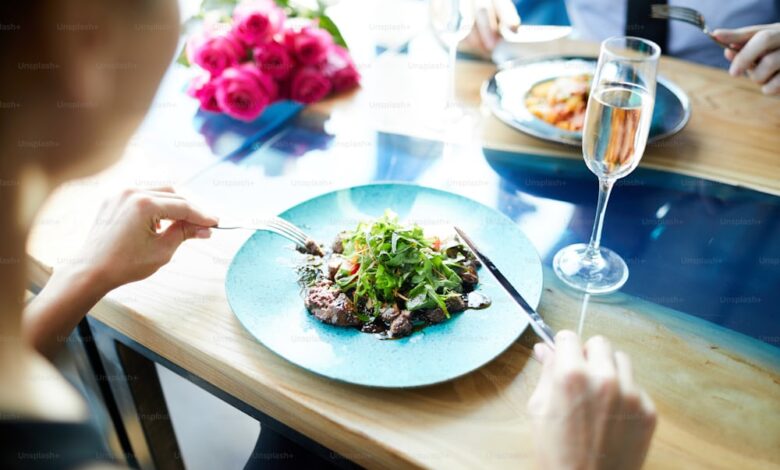Dining in Style: How to Enhance Your Restaurant’s Atmosphere

When guests step into your restaurant, they’re not just looking for a meal—they’re seeking an experience. The atmosphere of your restaurant plays a crucial role in shaping this experience, influencing everything from how long customers stay to how much they enjoy their food. A well-crafted ambiance can turn a simple meal into a memorable occasion, encouraging repeat visits and word-of-mouth referrals. Here’s how to enhance your restaurant’s atmosphere to ensure every diner leaves impressed.
1. Lighting: Setting the Mood
Lighting is one of the most powerful tools at your disposal for creating the right mood. It can turn a casual dining room into a romantic escape or a lively gathering place. Consider the type of experience you want to offer:
- Soft, warm lighting creates an intimate and cozy atmosphere, perfect for romantic dinners or upscale dining. Use dimmable lights, candles, or soft lamps to achieve this effect.
- Bright, natural lighting is ideal for casual, family-friendly restaurants or breakfast and brunch spots. Large windows and skylights can help flood the space with daylight, making it feel open and welcoming.
- Accent lighting can highlight specific areas, like artwork, architectural features, or even the bar area. This adds visual interest and draws guests’ attention to focal points in your restaurant.
Balance is key. Avoid overly harsh or too-dim lighting, as both can detract from the dining experience.
2. Soundscaping: Curating the Right Soundtrack
Sound is often an overlooked aspect of restaurant ambiance, yet it significantly impacts how guests perceive their environment. The right music can enhance the mood, while the wrong choice can be off-putting.
- Choose music that aligns with your brand. For a chic, modern restaurant, consider contemporary or jazz music. A traditional eatery might benefit from classical or cultural tunes that reflect its heritage.
- Control the volume. Music should be audible but not overpowering, allowing for conversation without guests having to raise their voices. Use a quality sound system with speakers positioned to distribute sound evenly throughout the space.
- Consider acoustic treatments. If your restaurant tends to get loud, especially during peak hours, sound-absorbing materials like acoustic panels or soft furnishings can reduce noise levels and create a more comfortable environment.
3. Interior Design: Reflecting Your Brand’s Identity
The interior design of your restaurant is a direct reflection of your brand’s identity. Every element, from the color scheme to the furniture, should be thoughtfully chosen to create a cohesive look and feel.
- Color Scheme: Colors evoke emotions and can influence how guests feel in your space. Warm colors like red and orange stimulate appetite and create a lively atmosphere, while cooler tones like blue and green can have a calming effect.
- Furniture and Layout: The furniture you choose should be both functional and stylish. Comfortable seating is essential, but it should also fit the overall aesthetic of your restaurant. The layout should facilitate easy movement for both guests and staff, avoiding overcrowded or awkward spaces.
- Decor: Artwork, plants, and other decorative elements add personality to your restaurant. Choose pieces that complement your theme and create visual interest. For a more personalized touch, consider featuring local artists or incorporating elements that tell the story of your restaurant’s journey.
4. Temperature: Ensuring Comfort
Maintaining a comfortable temperature is essential to ensuring a pleasant dining experience. If a room is too hot or too cold, diners may feel uncomfortable and be inclined to leave early. To avoid this, invest in a dependable HVAC system and consistently monitor the temperature during service hours.
Pay attention to seating arrangements concerning vents or windows to prevent drafts or overly warm areas. For restaurants in Scottsdale, partnering with a local air conditioning service can help ensure your HVAC system is running efficiently, keeping your guests comfortable year-round.
5. Scent: Engaging the Senses
The scent is a subtle yet powerful way to influence your restaurant’s atmosphere. The aroma of freshly cooked food is often enough to make guests’ mouths water, but you can also enhance the dining experience with other scents.
- Use scented candles or diffusers to create a welcoming environment. Choose subtle, food-related scents like vanilla or citrus that won’t overpower the natural aroma of your dishes.
- Keep the air fresh by ensuring proper ventilation, especially in the kitchen. Unpleasant odors can quickly turn guests away.
6. Service: The Human Touch
Finally, the atmosphere isn’t just about the physical environment—it’s also about how guests are treated. Friendly, attentive service can make a huge difference in how guests perceive your restaurant.
- Train staff to be welcoming and professional. A warm greeting at the door sets the tone for the entire meal. Staff should be knowledgeable about the menu, able to make recommendations, and quick to address any issues.
- Create a personalized experience by remembering regular customers’ preferences or offering special touches, like a complimentary appetizer for a celebration.
In Conclusion
Enhancing your restaurant’s atmosphere is an investment in your guests’ overall experience. By paying attention to details like lighting, sound, design, temperature, scent, and service, you can create a dining environment that not only attracts customers but keeps them coming back for more. Remember, a great atmosphere isn’t just about style—it’s about making every guest feel welcome and special.





